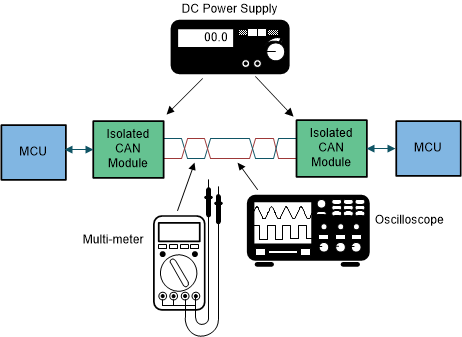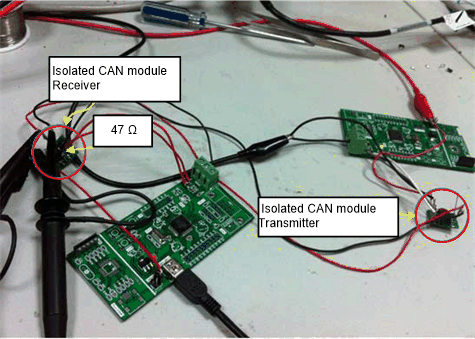SLLA334B August 2018 – September 2022 ISO1050 , SN6501
4 Experiment Validation
To validate the reference design including a 5-V isolated power supply and an entire module communication function, a test bench is set up (see Figure 3-6). Two MCU control boards are used with essential equipments: 6/2 digit multimeter (34401A-Agilent), oscilloscope (TPS2024- Tektronix), and DC power supply (GPS3303-GWINSTEK).
 Figure 4-1 Isolated CAN Module Test Setup
Figure 4-1 Isolated CAN Module Test SetupA nonisolated CAN device SN65HVD1050 is used as receiver in the experiment to test an isolated CAN module. One MCU sends a prefixed data sequence (handshake) via isolated CAN module. The other MCU receives the data through SN65HVD1050 and checks the error rate at the same time; if an error is found, a green LED on the receiver MCU board turns off. The oscilloscope is also used to observe the CAN bus waveform: 250 Kbps, 500 Kbps, and 1 Mbps data rates are tested and no data errors are found. The second experiment uses two isolated CAN modules as transmitter and receiver, respectively. The same data rates as in the first experiment are tested successfully.
 Figure 4-2 Fully Loaded bus Test (Waveform of CANH, CANL at a 1-Mbps Data Rate)
Figure 4-2 Fully Loaded bus Test (Waveform of CANH, CANL at a 1-Mbps Data Rate)Bus loading is an important feature for a CAN device. This feature is related to the driver current capacity of a CAN transmitter. Larger output current ability means more nodes can be added on the bus, assuming other conditions remain the same. For isolated CAN, the isolated power supply must provide enough current for the required output swing when the bus is fully loaded. In the CAN standard of ISO 11898-2, the differential output must be greater than 1.5 V with a 60- Ω load, and must be greater than 1.2 V with a fully loaded bus (bus node of a CAN device also depends on receiver differential input impedance besides the driver capacity).
long as the power supply is stable and does not drop when larger current is drawn by ISO1050 with heavy loading, the device can support at least 167 nodes. For this isolated power designed by SN6501, 100 mA on the secondary side is ensured. To test bus loading capacity of the module, a 167-transceiver network is simulated by a resistor. The differential input resistance of ISO1050 is a minimum of 30 kΩ with a maximum of 80 kΩ. Assume 167 nodes are in parallel on a bus with all 30-kΩ resistance: this is equivalent to a 180-Ω differential load. Take two 120-Ω termination resistors into account: this yields a total 45 Ω. In the test, a 47-Ω resistor is shunted on the receiver side. The data rate test is successful at 250 Kbps, 500 Kbps, and 1Mbps. Figure 4-2 shows the waveform of CANH, CANL at 1 Mbps data rate. The differential output voltage is 2.4 V, which is in the range of 1.4 to 3 V (the value ensured by the data sheet) and also has more margin for 1.2 V (ISO11898-2 requirement).